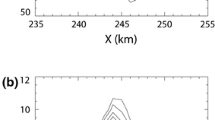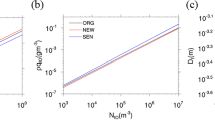Abstract
Cloud and precipitation parameterization schemes are evaluated, and their sensitivity to the method and/or parameters used to determine cloud physical processes is examined using a singlecolumn version of the Unified Model (SCUM). In the experiment for TWP-ICE, cloud fraction is overestimated (underestimated) in the upper (lower) troposphere due to the wet (dry) bias. The precipitation rate is well simulated during the active monsoon period, but overestimated during the suppressed monsoon and clear skies periods. In the moist convection scheme, trigger condition and entrainment process affect the lower tropospheric humidity through the impact on convective occurrence frequency and intensity, respectively. Strengthening the trigger condition and using the adaptive entrainment method alleviate the low-level dry bias. In the microphysics scheme, more large-scale precipitation is produced with prognostic rain, due to rain sedimentation considering vertical velocity of rain drop, than with diagnostic rain. Less ice/snow deposition with the prognostic two-ice category results in lower ice water content and upper-level cloud fraction than with the diagnostic splitting method for the twoice category. In the cloud macrophysics scheme, the prognostic cloud fraction and cloud/ice water content scheme produces a larger cloud fraction and more cloud/ice water content than the diagnostic scheme, mainly due to detrainment from moist convection (cloud source) that surpasses the effect of convective heating and drying (cloud sink). This affects temperature by influencing the radiative, convective, and microphysical processes. The experiment with combined modifications in cloud and precipitation schemes shows that interaction between modified moist convection and cloud macrophysics schemes results in more alleviation of the cold bias not only at the lower levels but also at the upper levels.
Similar content being viewed by others
References
Arakawa, A., and W. H. Schubert, 1974: Interaction of a cumulus cloud ensemble with the large-scale environment. Part I. J. Atmos. Sci., 31, 674–701.
Bechtold, P., and Coauthors, 2000: A GCSS model intercomparison for a tropical squall line observed during TOGA-COARE. II: Intercomparison of single-column models and a cloud-resolving model. Quart. J. Roy. Meteor. Soc., 126, 865–888.
Brown, A. R., R. J. Beare, J. M. Edward, A. P. Lock, S. J. Keogh, S. F. Milton, and D. N. Walters, 2008: Upgrades to the boundary-layer scheme in the Met Office numerical weather prediction model. Bound.- Layer Meteor., 128, 117–132.
Cardwell, J. R., T. W. Choularton, D. Wilson, and R. Kershaw, 2002: Use of an explicit model of the microphysics of precipitating stratiform cloud to test a bulk microphysics scheme. Quart. J. Roy. Meteor. Soc., 128, 573–592.
Clothiaux, E. E., T. P. Ackerman, G. G. Mace, K. P. Moran, R. T. Marchand, M. A. Miller, and B. E. Martner, 2000: Objective determination of cloud heights and radar reflectivities using a combination of active remote sensors at the ARM CART sites. J. Appl. Meteorol., 39, 645–665.
Davies, L., and Coauthors, 2013: A single-column model ensemble approach applied to the TWP-ICE experiment. J. Geophys. Res., 118, 6544–6563, doi:10.1002/jgrd.50450.
Edwards, J. M., and A. Slingo, 1996: Studies with a flexible new radiation code. I: Choosing a configuration for a large-scale model. Quart. J. Roy. Meteor. Soc., 122, 689–719.
Field, P. R., 1999: Aircraft observations of ice crystal evolution in an altostratus cloud. J. Atmos. Sci., 56, 1925–1941.
Franklin, C. N., C. Jakob, M. Dix, A. Protat, and G. Roff, 2012: Assessing the performance of a prognostic and a diagnostic cloud scheme using single column model simulations of TWP-ICE. Quart. J. Roy. Meteor. Soc., 138, 734–754.
Fridlind, A. M., and Coauthors, 2012: A comparison of TWP-ICE observational data with cloud-resolving model results. J. Geophys. Res., 117, D05204, doi:10.1029/2011JD016595.
Gregory, D. R., and P. R. Rowntree, 1990: A mass flux convection scheme with representation of cloud ensemble characteristics and stabilitydependent closure. Mon. Wea. Rev., 118, 1483–1506.
Jakob, C., 2003: An improved strategy for the evaluation of cloud parameterizations in GCMs. Bull. Amer. Meteor. Soc., 84, 1387–1401.
Klocke, D., R. Pincus, and J. Quaas, 2011: On constraining estimates of climate sensitivity with present-day observations through model weighting. J. Climate, 24, 6092–6099.
Lock, A. P., 2001: The numerical representation of entrainment in parameterizations of boundary layer turbulent mixing. Mon. Wea. Rev., 129, 1148–1163.
Lock, A. P., A. R. Brown, M. R. Bush, G. M. Martin, and R. N. B. Smith, 2000: A new boundary layer mixing scheme. Part I: Scheme description and single-column model tests. Mon. Wea. Rev., 128, 3187–3199.
Marshall, J. S., and W. M. K. Palmer, 1948: The distribution of raindrops with size. J. Meteor., 5, 165–166.
May, P. T., J. H. Mather, G. Vaughan, C. Jakob, G. M. McFarquhar, K. N. Bower, and G. G. Mace, 2008: The Tropical Warm Pool International Cloud Experiment. Bull. Amer. Meteor. Soc., 89, 629–645.
Mellor, G. L., 1977: The Gaussian cloud model relations. J. Atmos. Sci., 34, 356–358.
Petch, J. C., M. Willett, R. Y. Wong, and S. J. Woolnough, 2007: Modelling suppressed and active convection. Comparing a numerical weather prediction, cloud-resolving and single-column model. Quart. J. Roy. Meteor. Soc., 133, 1087–1100.
Petch, J. C., A. Hill, L. Davies, A. Fridlind, C. Jakob, Y. Lin, S. Xie, and P. Zhu, 2014: Evaluation of intercomparisons of four different types of model simulating TWP-ICE. Quart. J. Roy. Meteor. Soc., 140, 826–837, doi:10.1002/qj.2192.
Randall, D. A., K.-M. Xu, R. J. C. Somerville, and S. Iacobellis, 1996: Single-column models and cloud ensemble models as links between observations and climate models. J. Climate, 9, 1683–1697.
Rutledge, S. A., and P. V. Hobbs, 1983: The mesoscale and microscale structure and organization of clouds and precipitation in midlatitude cyclones. Part VIII: A model for the “seeder-feeder” process in warmfrontal rainbands. J. Atmos. Sci., 40, 1185–1206.
Smith, R. N. B., 1990: A scheme for predicting layer clouds and their water content in a general circulation model. Quart. J. Roy. Meteor. Soc., 116, 435–460.
Sommeria, G., and J. W. Deardorff, 1977: Subgrid-scale condensation in models of nonprecipitating clouds. J. Atmos. Sci., 34, 344–355.
Sundqvist, H., E. Berge, and J. E. Kristjansson, 1989: Condensation and cloud parameterization studies with a mesoscale numerical weather prediction model. Mon. Wea. Rev., 117, 1641–1657.
Swann, H., 2001: Evaluation of the mass-flux approach to parametrizing deep convection. Quart. J. Roy. Meteor. Soc., 127, 1239–1260.
Tiedtke, M., 1989: A comprehensive mass flux scheme for cumulus parameterization in large-scale models. Mon. Wea. Rev., 117, 1779–1880.
Tiedtke, M., 1993: Representation of clouds in large-scale models. Mon. Wea. Rev., 121, 3040–3061.
Walters, D. N., and Coauthors, 2011: The Met Office Unified Model Global Atmosphere 3.0/3.1 and JULES Global Land 3.0/3.1 configurations. Geosci. Model Dev., 4, 919–941.
Wang, Y., L. Zhou, and K. Hamilton, 2007: Effect of convective entrainment/detrainment on the simulation of the tropical precipitation diurnal cycle. Mon. Wea. Rev., 135, 567–585.
Wilson, D. R., and S. P. Ballard, 1999: A microphysically based precipitation scheme for the UK Meteorological Office Unified Model. Quart. J. Roy. Meteor. Soc., 125, 1607–1636.
Wilson, D. R., and D. Gregory, 2003: The behaviour of large-scale model cloud schemes under idealized forcing scenarios. Quart. J. Roy. Meteor. Soc., 129, 967–986.
Wilson, D. R., A. C. Bushell, A. M. Kerr-Munslow, J. D. Price, and C. J. Morcrette, 2008a: PC2: A prognostic cloud fraction and condensation scheme. I: Scheme description. Quart. J. Roy. Meteor. Soc., 134, 2093–2107.
Wilson, D. R., A. C. Bushell, A. M. Kerr-Munslow, J. D. Price, and A. Bodas-Salcedo, 2008b: PC2: A prognostic cloud fraction and condensation scheme. II: Climate model simulations. Quart. J. Roy. Meteor. Soc., 134, 2109–2125.
Xie, S., T. Hume, C. Jakob, S. A. Klein, R. B. McCoy, and M. Zhang, 2010: Observed large-scale structures and diabatic heating and drying profiles during TWP-ICE. J. Climate, 23, 57–79.
Yang, B., and Coauthors, 2013: Uncertainty quantification and parameter tuning in the CAM5 Zhang-McFarlane convection scheme and impact of improved convection on the global circulation and climate. J. Geophys. Res. Atmos., 118, 395–415, doi:10.1029/2012JD018213.
Zhang, M. H., and J. L. Lin, 1997: Constrained variational analysis of sounding data based on column-integrated budgets of mass, heat, moisture, and momentum: Approach and application to ARM measurements. J. Atmos. Sci., 54, 1503–1524.
Zhao, C., and Coauthors, 2012: Toward understanding of differences in current cloud retrievals of ARM ground-based measurements. J. Geophys. Res., 117, D10206, doi:10.1029/2011JD016792.
Author information
Authors and Affiliations
Corresponding author
Rights and permissions
About this article
Cite this article
Kim, SY., Han, JY., Choi, IJ. et al. Evaluation of cloud and precipitation parameterization using a single-column model: A TWP-ICE case study. Asia-Pacific J Atmos Sci 50, 469–480 (2014). https://doi.org/10.1007/s13143-014-0037-2
Received:
Accepted:
Published:
Issue Date:
DOI: https://doi.org/10.1007/s13143-014-0037-2




